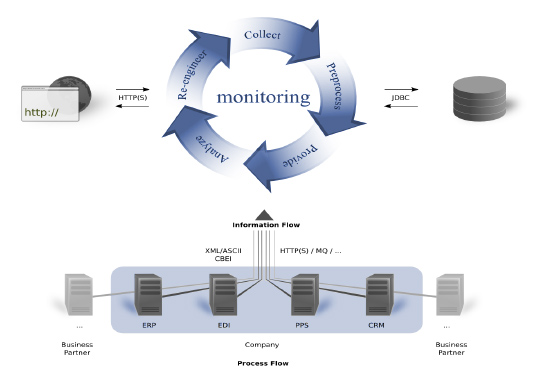Process Event Monitor edpem
The Process Event Monitoring system is an intelligent Software, which system independently allows professional preparation of process data and events of a great variety of business processes.
Thanks to its flexible meta-structure it is able to monitor every process and provide the generated information for the corresponding group of professionals. Doing this PEM is not limited to business internal processes but can reach out to other external processes. This is possible because focus does not lie on the business application but on the business process and the relationship to the business partner. PEM is used for the surveillance of SOA-Infrastructure and to receive, analyse and visualize process data and events. These functions are the foundation for detailed evaluation, to identify and remove bottlenecks via KPIs (Key Performance Indicators)

Use
The continuing, automated monitoring of the processes, in conjunction with a cause and influence analysis as well as the reports generated by them, significantly enhance the availability of the process. The clients receive a better service and solve their tasks without annoying interruptions. The employees are relieved of routine jobs and can concentrate on tasks that bring the business forward. The management of the IT-production is always able to give up-to-date and historic information to the corresponding services. This way, resources can be used differently within a short time, significantly reducing costs.
Action instead of reaction
The different departments are put into a place of action, instead of being condemned to react. Departments can now pro-actively monitor their processes and act if the need present. That is what many departments want. They do not want to be baggage for the IT-department and constantly generate expenses. The IT-departments on the other hand can relocate a lot of resources back to their own into their department. This way a lot of resources are freed up for the actual task at hand.
For the IT-department this means new freedom for innovation and new technologies, bringing a business into the future. The employees in the varying departments can now monitor their processes and process information by themselves, that way they are not bound to the IT anymore. All areas of a business can now take care of their own responsibilities, instead of involuntarily binding each other resources.
For the first time process data becomes visual for a department and the value of IT becomes measurable. In two short sentences this means:
PEM is Software to make transparent a heterogenic IT-landscape, to collect and centralize distributed information to inform departments with needed data. The collected data is the foundation for further analysis and process optimization.
The benefits are clear: Information doesn’t have to be laboriously brought together by an array of applications involved in the process, but can be directly prepared and visualized in a process-oriented way for the corresponding target group.
Infrastructure
The typical monitoring infrastructure exists of four components:
- Database
- Application Server / Monitoring Server
- Messaging Components
- Monitoring Client
As mentioned before, any relational database management system supported by the monitoring can be used for the data management.
An application server serves as runtime environment for the monitoring.
The messaging components are responsible for the transport of the relevant process information and events to the monitoring system. They represent the link between the information providing systems and the monitoring system.
There is a web-client that is provided for the users. It enables the user to wait on the monitoring system. This way the user can access the monitoring system from any computer via web browser. Monitoring is able to cluster. If necessary the infrastructure can be scaled, for example by running databases and/or application servers in the cluster.

